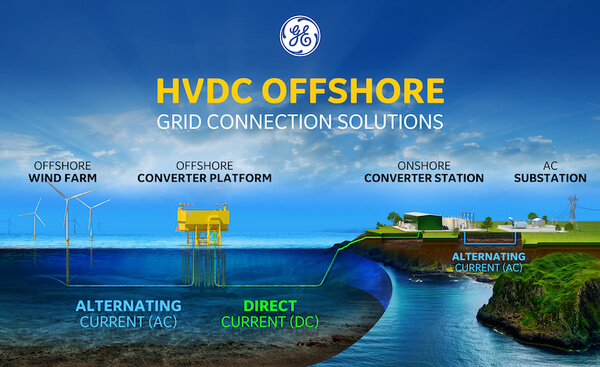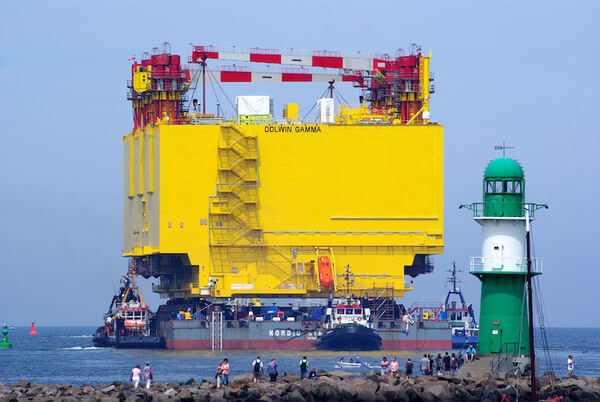News Release from GE Vernova
Wind Industry Profile of
Big Yellow Box: Long-Distance HVDC Transmission Will Support Next Wave of Offshore Wind Off North Sea Coast
But efficiently delivering power from offshore wind farms has its challenges due to the long distances that the power has to travel. The solution is high-voltage direct current transmission, or HVDC — the most efficient and economical solution for transmitting power over long distances and integrating it with the existing transmission grid.
GE Grid Solutions will lead two consortiums that will help to design and build — on and off the Dutch and German coasts — a powerful new grid with the capacity to handle these rising flows. In the Netherlands, GE and Sembcorp Marine have secured a framework agreement to build three offshore HVDC projects, while in Germany, GE is partnering with McDermott on two additional projects. Together they plan to provide a modern, HVDC solution that will help cover some 10 GW of the North Sea project. The two agreements are worth approximately 10 billion euros.

Image: GE Grid Solutions
“This is a big step in the energy transition not just for the Netherlands and Germany, but for all of Europe,” says Johan Bindele, Grid Systems Integration business leader of GE Grid Solutions. Bindele is leading a GE team that will help build the five approximately 525-kilovolt, 2-GW converter systems, which will transmit direct current through submarine cables from as far as 160 kilometers (100 miles) off the coast. The new offshore grid will be critical to delivering clean power to Europe.
According to Neil Beardsmore, executive commercial leader of GE Grid Solutions, HVDC is more efficient than high-voltage AC for offshore distances of more than 100 kilometers, and the technology is capable of transmitting more than three times the amount of power with up to 50% fewer losses. But to utilize HVDC, the offshore converter platform in the sea has to convert the AC power to HVDC first. The power is then transmitted through the HVDC cable system and converted back to AC power on land to connect to the onshore transmission system.
GE has been tasked with the electrical design and build to handle that conversion. The coordinator of the project, the Dutch-German transmission systems operator TenneT, has designed the new offshore grid to be anchored by 2-GW converter stations — “big yellow boxes,” Beardsmore calls them. This itself is a kind of breakthrough, according to Bindele and Beardsmore. Until now, offshore converter stations have varied in design and size, and currently range from 0.7 to 1.2 GW. TenneT saw the need to bring standardization to the industry, and Beardsmore says the 2-GW capacity brings the optimized and standardized design to the next technology level.

DolWin3 converter station (Image: GE Renewable Energy)
“The high-voltage equipment inside that big yellow box is GE equipment. This includes transformers, valves, controls, and protection systems. The scope of supply for the onshore substation is comparable,” says Beardsmore. The 2-GW capacity of the station — for comparison, that is equivalent to not one but two average-size nuclear plants — is just high enough to handle rising wind generation while at the same time coming right up to the limit of what the HVDC cable can handle. “This is not new technology for GE,” says Bindele. “It’s just so much bigger than anything the industry has seen before.”
TenneT has actually given its design a name, the 2GW Program, which is fitting because, according to Beardsmore and Bindele, this new standard will be replicated in every part of the supply chain, from cable manufacturers to HVDC conversion specialists like GE. One of the challenges that renewable technologies like wind and photovoltaic have presented to manufacturers is that they have leapt forward so quickly that they often render recent designs obsolete. Beardsmore quips that producers of large capital equipment “need a standard recipe, so that the cookies turn out well each time.”
TenneT’s 2GW Program is just the beginning. According to Beardsmore, the bigger vision is that this emerging offshore grid will eventually be part of interconnectors to the UK, Scandinavia, and European grids even farther away, eventually forming an HVDC transmission grid where power can be transmitted between multiple grid terminals, in different directions and to more than one country. The standardization of the 2-GW system proposed by TenneT allows for synergies and efficiencies in the delivery model, which bring both commercial and technical benefits.
The dawn of a new offshore grid comes at a time when Europe, while recovering from last year’s energy shock, is in no mood to forget its vulnerability. The Continent is clearly determined to move toward a CO2-neutral footprint and reduce its electricity generation from fossil fuels and dependency on Russian natural gas. The International Energy Agency declared last year that 2022’s shock will accelerate the energy transition. Here’s proof: Three million heat pumps were sold in Europe last year, a nearly 40% increase from 2021, according to the European Heat Pump Association. Heat pumps run on electricity and greatly reduce home heating needs. Of course, as Europe races to reduce its dependency on natural gas and oil, its demand for electricity will rise. While the aggressive offshore wind growth plans may strike some as ambitious, the rapid ascent of clean power is an essential part of the EU’s long-term goal to be climate-neutral by 2050.
- Source:
- GE
- Author:
- Gregor Macdonald
- Link:
- www.ge.com/...
- Keywords:
- GE, blog, story, HVDC, offshore, wind, transmission, grid, North Sea, MW, capacity, wind farm, power plant

























